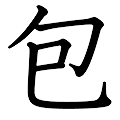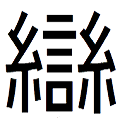About the old character forms and the new character forms
Leciel explains the old character forms and the new character forms, Bow-Wow.
As its name suggests, it refers to the new character forms and the old character forms, and the simplified forms of the original one is called the new character forms, although not all characters have the old and new character forms.Currently in Japan, there is Joyo Kanji designated by the country as "Indication of the use of Chinese characters when writing modern Japanese in general social life, such as laws and regulations, official documents, newspapers, magazines, and broadcasting", Bow-Wow.
At present, Joyo-Kanji consists of 2136 characters, but when Joyo-Kanji (At the time of its creation, it was called "Toyo Kanji.") was defined, the simplified form of the character was born, which is called the new character forms, Ruff-Ruff.
For example, if the character 旧字体 "the old character forms" is written in the old character forms, it becomes 舊字體.
You don't know what it say now, do you?
With the new character forms which became the simplified characters, the number of strokes has decreased and it is very simple and easy to remember, but from the point of view of Kanji study, there is a little problem.
In the process of simplification, the origin of the original characters (background) is lost.
As it was in the previous story of “Pack", she has lost its original meaning like this.  → 包 (巳 → 己)
→ 包 (巳 → 己)
However, Kanji characters that are not included in the regular Kanji characters, for example, 鮑“abalone” or 雹“hail”, are the old characters, and 巳 has not changed to 己.
This is also the reason that makes it difficult to remember Kanji.
Here are a few other examples of the old character forms, Bow-Wow.
Old character form: 國(country)-->New character form: 国(或-->玉)
Old character form: 戀(love)--> New character form: 恋( -->亦)
-->亦)
Old character form: 臭(smell)-->New style: 臭(犬-->大)
Dogs have such a keen sense of smell that the word "odor, smell, sniff " which means a dog's nose, came to mean "It smells bad.", but since the dot was omitted, it is not clear that the dog is the origin.
Actually, there are other letters that come from dogs.
Old character form: 器(serving dish)--> New character form: 器
Old character form: 淚(tear)--> New character form: 涙
Old character form: 類(kind)--> New character form: 類
In this way, while the shape of characters is simple in the new character form, the origin of original characters is often lost.
The same thing is happening in China, the birthplace of Kanji, and in Chinese there are "Simplified Chinese"(簡体字) and "Traditional Chinese"(繁体字), Bow-Wow.
"Traditional Chinese"(繁体字) is the old Japanese character form, and the simplified characters are called "Simplified Chinese"(簡体字).
I heard that "Simplified Chinese"(簡体字) is mainly used in China, but "Traditional Chinese"(繁体字) is mainly used in Taiwan, Bow-Wow!
Kanji is really difficult, Ruff-Ruff!!